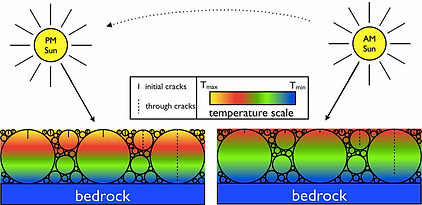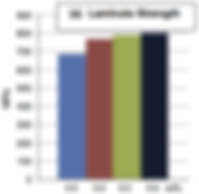top of page

NEPlab
Laboratory for
Nonequilibrium Phenomena
Publications
Materials in Extreme Environments


Delbo, M. Libourel G., Wilkerson, J.W., Murdoch, N., Michel, P., Ramesh K.T., Ganino, C., Verati, C. Marchi, S. "Thermal fatigue as the origin of regolith on small asteroids," Nature, 58:233-236, 2014.
Highlight: Regolith generation on small asteroids driven by thermal fatigue rather than impact processes as classically believed.
Abstract: Space missions and thermal infrared observations have shown that small asteroids (kilometer-sized or smaller) are covered by a layer of centimeter-sized or smaller particles, which constitute the regolith. Regolith generation has traditionally been attributed to the fall back of impact ejecta and by the break-up of boulders by micro-meteoroid impact. Laboratory experiments and impact models, however, show that crater ejecta velocities are typically greater than several tens of centimeters per second, which corresponds to the gravitational escape velocity of kilometre-sized asteroids. Therefore, impact debris cannot be the main source of regolith on small asteroids. Here we report that thermal fatigue, a mechanism of rock weathering and fragmentation with no subsequent ejection, is the dominant process governing regolith generation on small asteroids. We find that thermal fragmentation induced by the diurnal temperature variations breaks up rocks larger than a few centimeters more quickly than do micrometeoroid impacts. Because thermal fragmentation is independent of asteroid size, this process can also contribute to regolith production on larger asteroids. Production of fresh regolith originating in thermal fatigue fragmentation may be an important process for the rejuvenation of the surfaces of near-Earth asteroids, and may explain the observed lack of low-perihelion, carbonaceous, near-Earth asteroids.
Delbo, M. Libourel G., Wilkerson, J.W., Murdoch, N., Michel, P., Ramesh K.T., Ganino, C., Verati, C. Marchi, S. "Thermal fatigue as the origin of regolith on small asteroids," Nature, 58:233-236, 2014.
Highlight: Regolith generation on small asteroids driven by thermal fatigue rather than impact processes as classically believed.
Abstract: Space missions and thermal infrared observations have shown that small asteroids (kilometer-sized or smaller) are covered by a layer of centimeter-sized or smaller particles, which constitute the regolith. Regolith generation has traditionally been attributed to the fall back of impact ejecta and by the break-up of boulders by micro-meteoroid impact. Laboratory experiments and impact models, however, show that crater ejecta velocities are typically greater than several tens of centimeters per second, which corresponds to the gravitational escape velocity of kilometre-sized asteroids. Therefore, impact debris cannot be the main source of regolith on small asteroids. Here we report that thermal fatigue, a mechanism of rock weathering and fragmentation with no subsequent ejection, is the dominant process governing regolith generation on small asteroids. We find that thermal fragmentation induced by the diurnal temperature variations breaks up rocks larger than a few centimeters more quickly than do micrometeoroid impacts. Because thermal fragmentation is independent of asteroid size, this process can also contribute to regolith production on larger asteroids. Production of fresh regolith originating in thermal fatigue fragmentation may be an important process for the rejuvenation of the surfaces of near-Earth asteroids, and may explain the observed lack of low-perihelion, carbonaceous, near-Earth asteroids.
Delbo, M. Libourel G., Wilkerson, J.W., Murdoch, N., Michel, P., Ramesh K.T., Ganino, C., Verati, C. Marchi, S. "Thermal fatigue as the origin of regolith on small asteroids," Nature, 58:233-236, 2014.
Highlight: Regolith generation on small asteroids driven by thermal fatigue rather than impact processes as classically believed.
Abstract: Space missions and thermal infrared observations have shown that small asteroids (kilometer-sized or smaller) are covered by a layer of centimeter-sized or smaller particles, which constitute the regolith. Regolith generation has traditionally been attributed to the fall back of impact ejecta and by the break-up of boulders by micro-meteoroid impact. Laboratory experiments and impact models, however, show that crater ejecta velocities are typically greater than several tens of centimeters per second, which corresponds to the gravitational escape velocity of kilometre-sized asteroids. Therefore, impact debris cannot be the main source of regolith on small asteroids. Here we report that thermal fatigue, a mechanism of rock weathering and fragmentation with no subsequent ejection, is the dominant process governing regolith generation on small asteroids. We find that thermal fragmentation induced by the diurnal temperature variations breaks up rocks larger than a few centimeters more quickly than do micrometeoroid impacts. Because thermal fragmentation is independent of asteroid size, this process can also contribute to regolith production on larger asteroids. Production of fresh regolith originating in thermal fatigue fragmentation may be an important process for the rejuvenation of the surfaces of near-Earth asteroids, and may explain the observed lack of low-perihelion, carbonaceous, near-Earth asteroids.
Wilkerson, J.W., Ramesh K.T. "A dynamic void growth model governed by dislocation kinetics," J. Mech. Phys. Solids, 70:262-280, 2014.
Highlight: Dynamic growth of submicron voids governed by dislocation kinetics, with growth of micron-sized voids governed by micro-inertia.
Abstract: Here we examine the role of dislocation kinetics and substructure evolution on the dynamic growth of voids under very high strain rates, and develop a methodology for account-ing for these effects in a computationally efficient manner. In particular, we account for the combined effects of relativistic dislocation drag and an evolving mobile dislocation density on the dynamics of void growth. We compare these effects to the constraints imposed by micro-inertia and discuss the conditions under which each mechanism governs the rate of void growth.


The consequences of these constraints may be seen in a number of experimental observations associated with dynamic tensile failure, including the extreme rate-sensitivity of spall strength observed in laser shock experiments, an apparent anomalous temperature dependence of spall strength, and some particular features of void size distribution on spall surfaces.
Wilkerson, J.W., Ramesh, K.T. "Unraveling the anomalous grain size dependence of cavitation," Phys. Rev. Lett., 117, 215503, 2016.
Highlight: A micromechanics model predicting the anomalous grain size effect on spall strength of shocked metals.
Abstract: Experimental studies have identified an anomalous grain size dependence associated with the critical tensile pressure that a metal may sustain before catastrophic failure by cavitation processes. Here we derive the first quantitative theory (and its associated closed-form solution) capable of explaining this phenomena. The theory agrees well with experimental measurements and atomistic calculations over a very wide range of conditions. Utilizing this theory, we are able to map out three distinct regimes in which the critical tensile pressure for cavitation failure (i) increases with decreasing grain size in accordance with conventional wisdom, (ii) non-intuitively decreases with decreasing grain size, and (iii) is independent of grain size. The theory also predicts microscopic signatures of the cavitation process which agree with available data.





Nguyen, T., Luscher, D.J., Wilkerson, J.W., "A dislocation-based crystal plasticity framework for dynamic ductile failure of single crystals," J. Mech. Phys. Solids, 108, 1-29, 2017.
Highlight: Extensive theoretical development and validation against direct numerical simulations.
Abstract: A framework for dislocation-based viscoplasticity and dynamic ductile failure has been developed to model high strain rate deformation and damage in single crystals. The rate-dependence of the crystal plasticity formulation is based on the physics of relativistic dislocation kinetics suited for extremely high strain rates. The damage evolution is based on the dynamics of void growth, which are governed by both micro-inertia as well as dislocation kinetics and dislocation substructure evolution. An averaging scheme is proposed in order to approximate the evolution of the dislocation substructure in both the macroscale as well as its spatial distribution at the microscale. Additionally, a concept of a single equivalent dislocation density that effectively captures the collective influence of dislocation density on all active slip systems is proposed here. Together, these concepts and approximations enable the use of semi-analytic solutions for void growth dynamics developed in (Wilkerson and Ramesh, 2014), which greatly reduce the computational overhead that would otherwise be required. The resulting homogenized framework has been implemented into a commercially available finite element package, and a validation study against a suite of direct numerical simulations was carried out.
Multiscale mechanics of materials
Wilkerson, J.W., Ramesh, K.T. "A closed-form criterion for dislocation emission in nano-porous materials under arbitrary thermomechanical loading," J. Mech. Phys. Solids, 86:94-116, 2016.
Highlight: A continuum-based criterion for the emission of dislocations from nano-voids is derived and validated against atomistic calculations with favorable agreement.
Abstract: Our traditional view of void nucleation is associated with interface debonding at second-phase particles. However, under extreme dynamic loading conditions second-phase particles may not necessarily be the dominant source of void nucleation sites. A few key experimental observations of laser spall surfaces support this assertion. Here, we describe an alternative mechanism to the traditional view, namely shock-induced vacancy generation and clustering followed by nanovoid growth mediated by dislocation emission. This mechanism only becomes active at very large stresses. It is therefore desirable to establish a closed-form criterion for the macroscopic stress required to activate dislocation emission in porous materials. Following an approach similar to Lubarda and co-workers, we derive the desired criterion by making use of stability arguments applied to the analytic solutions for the elastic interactions of dislocations and voids. Our analysis significantly extends that of Lubarda and co-workers by accounting for a more general stress state, finite porosity, surface tension, as well as temperature and pressure dependence. The resulting simple stress-based criterion is validated against a number of molecular dynamics simulations with favorable agreement.




Wilkerson, J.W. "On the micromechanics of void dynamics at extreme rates," Int. J. Plasticity, 95:21-42, 2017.
Highlight: Despite the complexity of treating dislocation density as an evolving field quantity, analytic solutions are derived.
Abstract: In an earlier work, we derived evolution equations governing the dynamic growth of voids considering the combined retarding effects of micro-inertia and dislocation kinetics. Here we derive closed-form approximate solutions to these governing equations that accurately capture the transient evolution of void size history. In addition to being invaluable to the development of computationally-efficient dynamic ductile failure frameworks, these closed-form models help reveal deeper insights into the underlying physics governing complex dynamic void growth. In particular, we show that the transient effects of inertia are important for families of voids that nucleate from coarse, micron-sized second phase particles. For nano-sized voids the finite kinetics of dislocation substructure evolution towards a saturated state play a vital role. In
spite of the significant complexity associated with capturing an evolving substructure, an elegant closed-form approximation presents itself. These closed-form models are further bolstered by good agreement with molecular dynamics calculations. Lastly, we derive closed-form models of void size distribution evolution to confirm an experimentally observed transition in fracture surface characteristics above a critical loading rate.





Daphalapurkar, N.P., Wilkerson, J.W., Wright, T.W., Ramesh, K.T. "Kinetics of a fast moving twin boundary in nickel," Acta Materialia, 68:82-92, 2014.
Highlight: Kinetics of twin boundaries governed by the population and kinetics of twinning dislocations.
Abstract: A complete description of high-rate dynamic deformation of metals demands, in part, the fundamental understanding and characterization of twin boundary (TB) kinetics. We use molecular dynamics (MD) to characterize the TB kinetics in nickel, which serves as a model material for understanding TB kinetics in face-centered cubic metals. The kinetics of twinning dislocations (TD) fundamentally govern the TB kinetics. Propagation kinetics for a TD shares many common features with full dislocation kinetics, including non-linear kinetics, stable propagation regimes and forbidden velocities. However, a TD experiences an additional drag (as compared to a full dislocation) due to damping interactions with the TB; these characteristics are reflected in the TB kinetics. We show that, in Ni, TB velocities are limited to ~ 650 m/s, well below the shear wave speed. The insights gained from the MD simulations inform our proposed kinetic relations for TD and TB, and we show how these kinetic relations may be utilized in both macroscopic and crystal plasticity formulations.
Wang, P., Wei, G., Wilkerson, J.W., Liechti, K.M., Huang, R.
"Cavitation of water by volume-controlled stretching," Ext. Mech. Lett., 11:59-67, 2017.
Abstract:A liquid subjected to negative pressure is thermodynamically metastable. Confined within a small volume, negative pressure can build up until cavities form spontaneously. The critical negative pressure for cavitation in water has been theoretically predicted to be in the range of −100 to −200 MPa at room temperature, whereas values around−30 MPa have been obtained by many experiments. The discrepancy has yet to be resolved. In this study we perform molecular dynamics simulations to study cavitation of water under volume controlled stretching. It is found that liquid water exhibits a nonlinear elastic compressibility (or stretchability) under hydrostatic tension and remains stable within the confined volume until spontaneous cavitation occurs at a critical strain. Subsequently, as the volume-controlled stretching continues, the cavity grows stably and the hydrostatic tension decreases continuously until the box volume is large enough for another transition to form a water droplet. A modified nucleation theory is proposed to predict the critical condition for cavitation. In particular, a strong dependence of the critical strain and stress for cavitation on the initial liquid volume is predicted by the modified nucleation theory, which may offer a possible explanation for the discrepancies in the values of the critical negative pressure obtained from experiments.

Multifunctional nanomaterials
Davis, D.C., Wilkerson, J.W., Zhu, J., Hadjiev, V.G. "A strategy for improving mechanical properties of a fiber reinforced epoxy composite using functionalized carbon nanotubes," Composites Science and Technology, 71:1089-1097, 2011.
Highlight: Fatigue enhancement of carbon fiber composites obtained through the strategic incorporation of carbon nanotubes at the fiber-matrix interfaces.
Abstract: Carbon fiber reinforced epoxy composite laminates are studied for improvements in quasi-static strength and stiffness and tension-tension fatigue cycling at stress-ratio (R-ratio) = +0.1 through strategically incorporating amine functionalized single wall carbon nanotubes (a-SWCNTs) at the fiber/fabric-matrix interfaces over the laminate cross-section. In a comparison to composite laminate material without carbon nanotube reinforcements there are modest improvements in the mechanical properties of strength and stiffness; but, a potentially significant increase is demonstrated for the long-term fatigue life of these functionalized nanotube reinforced composite materials. These results are compared with previous research on the cyclic life of this carbon fiber epoxy composite laminate system reinforced similarly with side wall fluorine functionalized industrial grade carbon nanotubes. Optical and scanning electron microscopy and Raman spectrometry are used to confirm the effectiveness of this strategy for the improvements in strength, stiffness and fatigue life of composite laminate materials using functionalized carbon nanotubes.


Davis, D.C., Wilkerson, J.W., Zhu, J., Ayewah, D.O. "Improvements in mechanical properties of a carbon fiber epoxy composite using nanotube science and technology," Composites Structures, 92:2653-2662, 2010.
Highlight: Mechanical enhancement of carbon fiber composites obtained through the strategic incorporation of carbon nanotubes at the fiber-matrix interfaces.
Abstract: Carbon fiber reinforced epoxy composite laminates, with strategically incorporated fluorine functionalized carbon nanotubes (f-CNTs) at 0.2, 0.3, and 0.5 weight percent (wt.%) are studied for improvements in tensile strength and stiffness and durability under both tension-tension (R=+0.1) and tension-com-pression (R=-0.1) cyclic loadings, and then compared to the neat (0.0 wt.% CNTs) composite laminate material. To develop the nanocomposite laminates, a spraying technology was used to deposit nanotubes on both sides of each four-harness satin weave carbon fiber fabric piece for the 12 ply laminate lay up. For these experi-mental studies the carbon fiber reinforced epoxy laminates were fabricated using a heated vacuum assisted resin transfer molding (H-VARTM) method followed by a 2 soak curing cycle. The f-CNTs toughened the epoxy resin-fiber interfaces to mitigate the evolution of fiber/fabric-matrix interfacial cracking and delamination under both static and cyclic loadings. As a consequence, significant improvements in the mechanical properties of tensile strength, stiffness and resistance to failure due to cyclic loadings resulted for this carbon fiber reinforced epoxy composite laminate.



bottom of page